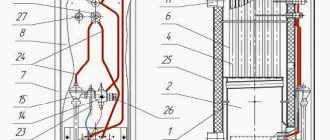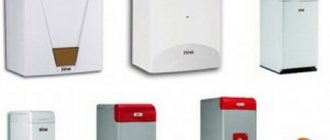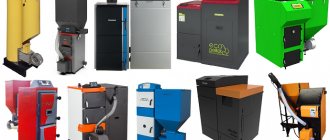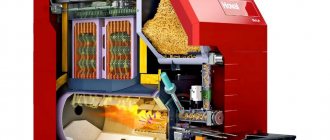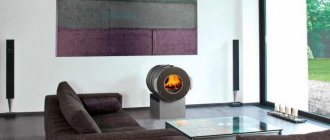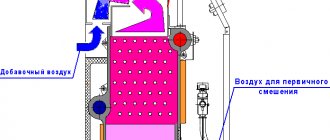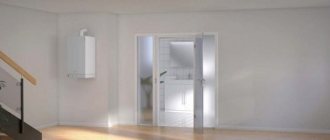Residents of private houses lament the fact that during the winter it becomes very annoying to light the stove every day. In some places, firewood and coal are becoming scarce.
The issue of environmental friendliness of fuel is also important in today’s world. That is why pellet boilers are in increasing demand.
User reviews show that they are worth the money. It is important to choose the right model; the review below will help with this.
Pellets
The compressed pellets, 6–8mm in diameter and up to 50mm in length, are made primarily from waste wood and are considered an environmentally friendly, renewable and carbon-neutral fuel. The granules are made without any kind of chemical additives. When burned, pellets emit more heat than wood, gas or diesel fuel. And at the same time, the price for them does not rise as catastrophically as for other types of fuel.
Pellets differ in their raw materials and the method of processing, which determine the color of the finished product. White pellets are obtained from wood waste. Gray - from a mixture of wood with bark and peat or seed husks. Black pellets are produced from the same raw materials, but by oxygen-free firing at high temperatures; their calorific characteristics are similar to coal, do not rot and are water-repellent.
Many boiler owners speak negatively about the quality of domestic pellets. Although it is difficult to rely only on reviews. Each region has its own producers of this type of solid fuel, and you can only find out what quality the pellets were after burning them. Even clean seed husks burn well and provide enough heat with the correct granule manufacturing technology. It is recommended to determine the approximate quality of granules by their appearance. They should be shiny, without cracks, at least 10 mm long, and not crumble into dust in your hands.
Pellet boilers
Solid fuel boilers, which use pellets as fuel, are used for heating private houses and small public buildings and heating water.
Modern automation allows you to maintain a comfortable temperature in the room, which can be set depending on the time of day and season. Wood pellets are fed from the hopper to the firebox as needed using a special auger, which is controlled automatically. When the set temperature is reached, the auger stops and the granules are not fed into the firebox. Typically, the volume of the bunker allows you to store a supply of pellets for several days. If you can organize a warehouse for storing pellets, from which they are immediately supplied to the bunker, then the process becomes more convenient . Experts recommend using a pellet boiler in combination with a backup device using another heat source, most often electricity. But today there are models on the market that can, if necessary, work with both wood and briquettes.
According to consumer reviews, which have something to compare with, in terms of requirements for location, installation and safe operation, pellet boilers are no different from gas or liquid fuel devices. Modern models are quite compact, differ from analogues in the small volume of the combustion chamber and a special burner with high efficiency. They are also characterized by a service life of up to twenty years (at least according to the instructions) and a high level of automation.
Manufacturers claim that if there is a special warehouse with a pellet supply system, the device can operate without human intervention throughout the entire heating season. According to reviews, an autonomous feeding system requires careful installation and precise adherence to geometry, otherwise granules will get stuck at the bends of the pipes, disrupting the smooth operation of the system.
Pellet boilers are available in various capacities, from 15 to 100 kW . Manufacturers recommend determining the required boiler power at the rate of 1 kW per ten square meters of area plus fifteen percent for the heat loss of the house. Reviews from owners of country houses confirm these data. Since houses are built and insulated for domestic winters, even without a margin of fifteen percent, the temperature in the rooms is maintained at a comfortable level.
Advantages of pellet boilers
Pellet boilers have undoubted advantages:
- Pellets are by far the safest fuel when compared to gas and electricity. But no one mentions such a positive aspect, and, most likely, because no one had any problems in this regard.
- Significantly reduce heating costs compared to electric ones. They have been actively used in Russian realities for several years now, and the reviews of their owners can be trusted. These are not theoretical calculations from foreign sources, but a statement of fact. Some say the costs are reduced by half, others by thirty percent (if you use a two-tariff meter) compared to electric heating devices. With regard to gas, the situation is the opposite. But gas is not available everywhere, and even gas cylinders are not always available. And gas is an explosive substance, unlike pellets.
- High efficiency up to 95% . Manufacturers talk about 97% in some models.
- Availability of an additional hot water supply circuit.
- Pellets are convenient to transport and store, they do not cause allergic reactions, are environmentally friendly and non-toxic. The only requirement for the room for storing them is dryness.
- Pellets are becoming more affordable every year. Today there are already many enterprises producing wood pellets. If several years ago consumer reviews spoke of a shortage of such fuel and the need to stock up on it from the summer for the entire heating season, now the excitement has subsided, and no one sees the need to store ten tons of fuel at once.
- The price of pellets is more stable than electricity or gas tariffs, and now that more and more of them are being produced, its seasonal fluctuations are not so noticeable.
- Heating a country house using a pellet boiler does not require approval for connection and operation; if desired, the equipment can be installed independently.
- Ash after combustion of pellets consists of natural minerals, and there are no problems with its disposal, as their owners have repeatedly noted on forums.
Design and operating principle
The center or the most important element of this device is the burner; almost the entire process is concentrated in it, and it is also connected to the boiler controller, to which, in fact, it is subordinate.
There are two types of burners:
- Retort.
- Torch.
A retort burner has the form of a bowl made of cast iron or heat-resistant steel in which the fuel combustion process occurs. Fuel enters it from below. In order for the surface to cool in the combustion zone, primary air is supplied from the sides of the bowl.
There is also a supply of secondary air through the hole in the burner, or other technological holes in the design of the device. The ash that is formed during combustion falls from the retort burner under the influence of incoming fuel. During operation, the flame is directed upward; this must be taken into account when designing a pellet boiler.
This type of burners is divided into movable and stationary. The first type is capable of operating on high-ash fuel, as well as on fuel with dust impurities such as wood chips, sawdust, and coal with dust. The second type operates exclusively on dry homogenized fuel, such as high-quality fine coal and wood pellets.
The flare is a pipe, which is the combustion chamber. It all works as follows: pellets are fed from one side using a screw, and a horizontally directed flame comes out of the other end. Air injection occurs from the fuel ingress side. This type of burner is the most common, since in retort burners the fuel supply mechanism often goes astray due to clogging.
So, let's look at how this device works in more detail using the example of a torch burner. The chamber where the combustion process occurs is located inside the boiler; the outer part of the burner is made in the form of a housing, where there is an auger that serves to transport pellets and a fan for air supply.
In order for the electric ignition to work and to be able to maintain the flame, a control board, a photosensor and an incandescent element are provided. There is a fuel supply hole at the top.
In action it looks like this: a command is received from the controller to the auger and it starts supplying a small amount of fuel into the chamber, then it stops. The incandescent element turns on and the fan starts working, which causes the pellets to ignite.
Next, the photosensor detects the presence of a stable fire and sends a signal to the control unit, which turns off the incandescent element. Then it works in the mode described above.
There are models on the market in which the storage hopper is installed above the burner nozzle, this in turn allows fuel to flow into it without passing through an additional conveyor.
Pellet boiler with top hopper
Disadvantages of pellet boilers
It would seem that pellet stoves have so many advantages that they should already be in every country house, but the disadvantages get in the way:
- Quite a high price. It has been declining in recent years, but still exceeds the cost of gas and electric analogues. The cost of a pellet boiler is twice as high as a gas boiler of the same power. But there are separate burners that can be installed in an existing solid fuel boiler.
- Need for constant care . Throughout the heating period, almost every week you need to clean the heat exchanger with a special brush and remove ash from the ash collector. True, this applies to outdated models. Modern devices have an automatic cleaning function. And the frequency of such work directly depends on the quality of the pellets. This drawback is noted by all owners of pellet stoves.
- If there is no warehouse with automatic supply of pellets, the bunker must be loaded manually at least once a week, depending on its size. But this is a common drawback of all solid fuel devices.
- The need for a sufficiently large dry room for storing pellets. Even for the smallest 10 kW boiler, according to reviews, 2 kg/hour or 2 bags of 25 kg of pellets per day are required, that is, about one and a half tons of pellets are needed for a month, and they need to be stored in a dry room or a large container. True, the environmental safety and absence of odors in pellets allows this volume to be used for other purposes in the warm season.
- In remote areas, there may be complications with the purchase of high-quality pellets, their delivery and servicing of imported equipment, which, to be honest, was not designed for the harsh Russian winters and the quality of the fuel.
What to look for when choosing
What parameters will make the purchase the most profitable? Please note the following:
- Certificate. Be sure to purchase a product with a certificate - it indicates the safety of the device.
- Type of granules. Pay attention to the pellets that are used in certain types of boiler. Some models have specific instructions for the type of granules.
- Power. The more powerful the device, the better – this model will work longer in autonomous mode.
- Container volume. This parameter affects the frequency of boiler maintenance. The smaller the volume, the more often you will have to change fuel.
- Principle of operation. There are two options here: either a boiler with automatic regulation or a manual one. Choose the one that is more convenient for you personally.
Leading manufacturers
There are now devices from Russian and foreign manufacturers on the market.
Russian-made boilers
Despite the fact that most owners agree that they have more disadvantages than advantages, Russian pellet makers are produced by several serious enterprises:
- It is worth highlighting “Oranges” produced by NCC Biyskenergoproekt, which got their name for their bright color. They are characterized by an optimal price-quality ratio and an efficiency of 93% with ease and reliability of use. "Orange" is equipped with electronic control, automated fuel loading and forced ventilation. Focused on the domestic pallet market with their quality. At the same time, the cost of “Oranges” is on average 150 thousand rubles.
- Start boilers are manufactured in Chelyabinsk, however, they are equipped with Polish volumetric combustion burners, which allow complete combustion of fuel and high efficiency. “Start” is a combination boiler and, in addition to pellets, can operate on coal, wood, and small chips. For this purpose, the kit includes a cast iron grate, which is installed instead of the burner. Price ranges from 130-250 thousand rubles.
- The Krasnoyarsk Zota Pellet consumes various types of fuel; its functions include the ability to control the heating process using SMS messages. The line includes five models with a power from 15 to 100 kW, which are used in closed heating systems (with forced circulation). According to reviews, they functionally correspond to the Finnish Auterm Biomatic, but are half the price, and the Grandeg models of the same price category are one step lower in function.
- Pellet boilers "Kupper" LLC "Teplodar" from Novosibirsk, whose power ranges from 10 to 40 kW, are converted conventional solid fuel boilers with a pellet burner. Owners note its low price of about 80 thousand rubles depending on the model, the difficulty of setting up, the need to select high-quality pellets and minor modifications such as grinding the auger bolt (it protrudes very much, because of this the pellets get stuck in the hopper).
Our village is small, they promised to supply gas in three years. I wanted to install solid fuel heating, but there was nowhere to store firewood and no time to do it. Service technicians will not come to us, so I chose a boiler from a serious specialized plant. I chose “Kupper” , which is one and a half times cheaper than other manufacturers of the same power. With the difference in price, I will be able to heat a 100 square meter house for just two years.
Fedor Mikhailovich
Comparison table of the presented models
Basic information on the technical parameters of each of today's models is presented in a brief table.
| Model | P (kW) | Efficiency % | S heating (m²) | Weight, kg) |
| ZOTA Pellet 25S | 25 | 90 | 250 | 395 |
| Sunsystem V2 25KW/PLB25 – P | 27 | 96 | 250 | 488 |
| Kostrzewa Pellets Fuzzy Logic 2 | 25 | 92 | 250 | 430 |
| Kiturami KRP 20A | 24 | 92 | 330 | 210 |
| ACV ECO Comfort 25 | 25 | 88 | 250 | 428 |
| Cooper OK 20 | 20 | 95 | 200 | 99 |
| Pelletron 40 CT | 40 | 92 | 400 | 120 |


